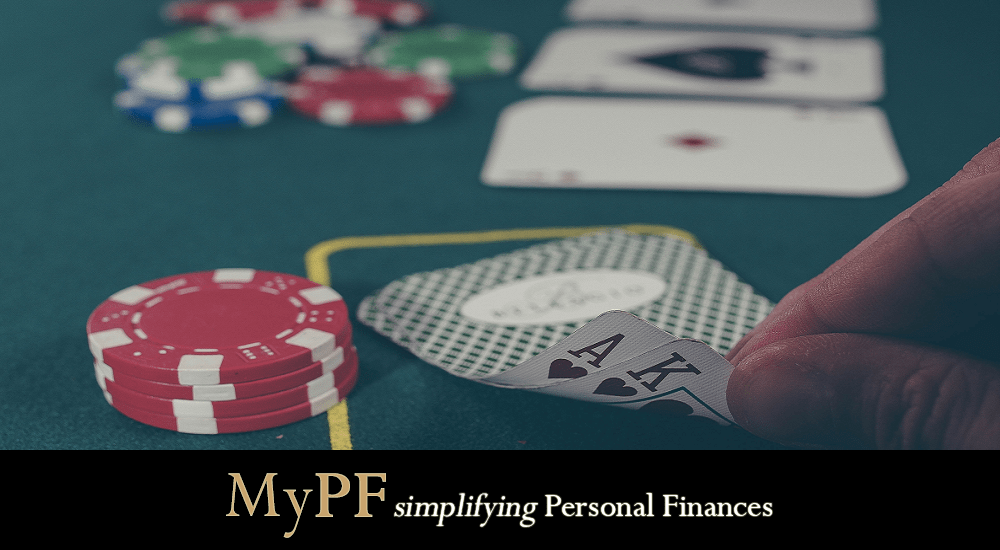Do you think you can make sound judgments or decisions? I believe you can. We, humans, are intelligent creatures. We can think logically and weigh the pros and cons before making a decision. But when it comes to investing, the ability to make sound investing judgment is questionable. Why is that?

Psychology has influence and power over investors’ investing behaviour and decision-making.
Researchers have unveiled the influences of psychological biases over investors behaviour which subsequently affect the stock markets. You may assume that these biases a fallacy, mistaken-belief, or myth. However, many investors are indeed unknowingly influenced by theses biases which affect their investment decisions.
Financial-wise, these fallacies or biases, can harm you if you are not careful.
What are these investing fallacies? Why should you work on avoiding them? How do you avoid or overcome these fallacies?
- Sunk Cost Fallacy
- Hot Hand Fallacy
- Gambler’s Fallacy
- Loss Aversion Bias
- Over Analysis Fallacy
- Confirmation Bias

Contents
1. Sunk Cost Fallacy
Actions that create further loss in an attempt to recover losses from an earlier decision
What is it?
Sunk cost is a past cost (including time wasted or non-cash resources) paid, irrecoverable regardless of any subsequent actions.
For example, you paid RM1,000 for a business convention. The night before the event, you became ill (cold, cough & fever) and have trouble stepping off the bed. Instead of seeking medical help, you attended the convention because you don’t wish to squander the RM1,000 paid. Sunk cost fallacy rearing its ugly head!
Why avoid it?
It can make you act foolishly and incur a further loss.
The RM1,000 paid is non-refundable, gone, kaput, regardless of your attendance. Not seeking medical help but instead attending the convention, it worsens your health condition (incurring a further loss) . You can’t concentrate during the convention. And embarrassingly enough, your constant coughing distracts the other attendees of the convention, giving yourself a black name.
How to avoid or overcome it?
It’s tough. Nobody likes losing. When we lose, the feeling is awful! But when we win, our reaction is nonchalant as we had expected a return from our investment (money, time, or resources). Human feels more suffering from losses than joy from winning. We continue to make a poor decision seeking to “fix” the situation to recover the earlier loss. Instead, we lose further.
To conquer it:
- Practice awareness and logical thinking to make rational decisions
- Determine your limit for loss and gains before selling or buying further. The concept of anticipation reduces the agony of losing.
- List out the pros and cons of the next action. This gives you a clear view of whether it’s a worthwhile action.
Everyone experienced failures during their lifetime. But these fails are the best educator. Allow yourself to fail sometimes but learn from the failure and plan for a way out.
2. Hot Hand Fallacy
What is this?
This is the false belief that recent winning streak will continue to the future without regards to other available data.
For example, a particular share has made profits every day for the past 15 days. Based on this profitability streak alone, an excited investor pumped in more money to invest than he could afford, betting it will continue to rise regardless of other economic indicators. The investor only consider one factor for buying the share i.e. the current price upward trending of the share.
Why avoid it?
For investing, being foolhardy is dangerous when the market is bullish.
Following up on the example above, imagine when emotions are running high. Prices rising for 15 days in a row and the market talk says it will continue to increase for the next 10 days. Everybody is buying. In your mind, you are thinking if you don’t buy, you will lose out (herd mentality). Thus, you invest more money than you can afford. All the time-tested sound investment principles forgotten in the midst of the excitement. The next day, Bang!… the market collapses (an extreme assumption) or the share price suddenly make a sharp downturn.
Have you wondered why do sellers of successful mutual funds always add a common disclaimer of “past performance is not indicative of future results”?
How to avoid or overcome it?
It‘s wise to be cautious. Investing with emotion is gambling. Instead of placing an investment decision on recent events, analyse the trends and patterns of the share price movements. Unless you look for short-term gain, long-term investing is the way.
All debatable issue has it followers and the detractors. Seek the view of the detractor, someone who disagreed with further buying of the above share. Get their viewpoint. But insist on credible data.
Practice sound investing principles before parting your money.

3. Gambler’s Fallacy
A win expected after a succession of losses (or vice versa)
What is this?
Gambler’s fallacy is an incorrect presumption that say:-
- If a particular event/effect/result happens again and again in a row, the opposite result is certain to occur soon.
- We often interprets the outcomes of a future event by judging its corresponding past events even if the two are completely independent of each other.
Best example to illustrate this fallacy is the coin toss. Assuming the first four toss is all head, what do you think will be the fifth toss? Head or tail? Tail right? Since head four times in a row. That’s the answer given by most people. And this is Gambler Fallacy at play. Probability theory suggest the answer is 50/50 for either head or tail. Past tosses do not influenced future toss result.
Why you should avoid it
Emotional investing using your heart would not generate wealth for you. The Stock Market operate based on the underlying company fundamentals.
In investing, Gambler’s fallacy is widespread. Investors believed that a share price continuous daily climb can’t be forever. As such, many start to sell prematurely and lose out.
The day share price is independent to the previous days prices. Investor should base their buy or sell decision on fundamental analysis. (fundamental analysis refers to the examination of the economic health of an entity as opposed to only its price movements).
How to avoid it
Always remember this. Your past successes or failures have no influence on the result of your next transaction. Investors should use fundamental analysis to predict what will happen.
Don’t gamble. Stop making investing decisions that depend completely on probability.
4. Loss Aversion Bias
What is this?
An investor placed more importance in avoiding losses than making profit.
For example, it is better to not lose $1,000 than it is to gain $1,000. An investor with loss aversion will feel the suffering of a loss twice as much if he makes a gain.
Why you should avoid it
Nobody like to lose especially when it comes to our investments. Many investors prefer not to lose money more than winning. In the risk-reward model, more weightage is placed on the risk factor. Resulting in inaction being the reasonable action.
Loss aversion can: –
- Stop and prevent investor from disposing loss-making investments.
- make investors overthink on avoiding risk when assessing possible gains. Evading loss prioritise over making a profit.
- Make you hold on to losing investment and sell the winners. Causing investors to hold unbalanced portfolios.
Investors should take calculated risk to increase gains, not to mitigate losses.
How to avoid or overcome it
Alter your attitude.
Losing is part of the investment game. No risk, no gain. Prepare a investment plan before you get into a trade. Give your investments some trading space to move and don’t set your stop losses too tight.
Misfortune is rooted on our mind. Whatever choice we do (although it is the most sensible), we try to become loss averse.
Giving up due to loss averse bias without justification would reduce your chances of winning. For example, if you don’t start up a business you always dreamed off just because you worried about losing money, you will lose.. in the real sense .
Know this, the greatest risk is living a risk-free life.
From the other side of the argument, somehow we can enjoy loss aversion bias too. Loss aversion bias serve a new investor to avoid loss i.e. being less eager about making more money.

5. Over Analysis Fallacy
What is it?
Analysis Paralysis. You over analysed a situation resulting to inaction i.e. no outcome. Too much information resulting in brain freeze or paralysis.
Why you should avoid it?
Often, you came across a good investment deal. Your gut feeling is telling you to go for it. The main indicators are there. But your analytical background is cautioning you to analyse further. You cave-in (loss aversion bias) and seek further information. The more data you analyse the more you are unsure and get confused about it. The deal passed by and that that. No action, no outcome. And the actual outcome? You lost a chance to a 20% gain after 3 months.
How to avoid it
Many investors over analyse with many statistics, indicators, checklist to fill in. There are news to look at, expert‘s opinion and other indicators to digest. They want to be 100% sure they got it right (perfect result) before parting with their money. This lead to analysis paralysis.
Best solution? Stick to a consistent trading strategy. Briefly, your trading strategy should decide the following:
- If a share is cheap or expensive or fair value
- If a share is cheap/expensive, decide if you wants to buy/sell that asset
- Given that a share is fairly priced and if we hold a position in that share (bought or sold it earlier), decide if you wants to exit that position or the price (or price range) that you wants to make this trade at
6. Confirmation Bias
What is it?
An individual favors those recommendations or conclusions which establish his/her current belief.
It gets individuals to stick with information that confirms their own point of view. And rejecting any suggestion that disagrees with it.
Why avoid it?
Confirmation bias shows that an investor is prone to seek for knowledge that back his or her opinion. More than which differs with it. For e.g. when you identify a trading signal. You’re expected to notice indicators which support your opinion. And not those against it.
We receive contradicting information differently. Because of one-sided information which biases our frame of reference, we made flawed decisions .
Investors will have a partial picture of a situation because of confirmation bias.
How to avoid it
When everything seems to support your market view or reinforcing your idea, stop!. Reflect further and seek for reasons against your view. This can save you from slipping into the pit of over confidence.

Conclusion
Instead of looking at fundamentals in investing decisions, investors sometimes make the mistake of allowing human emotions take over. Humans are not always sensible and markets are not always efficient, leading to losses incurred from these emotionally-charged decisions (instead of fact-based decisions). Understanding and knowing these fallacies and biases will help you adjust your investment strategy towards a more fact-based habit, which helps you with your investments in the long run.




Great post Eric!